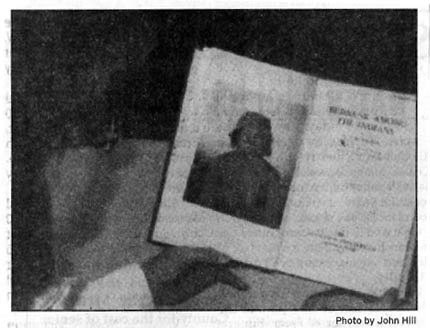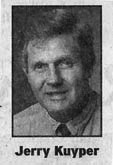
A. Crystal Lake library patron reads a copy of "Burbank Among the Indians."
The 1944 rarity was bought by the library for about $100 via the Internet in 2000.
E. A. Burbank was from Harvard.

A. Crystal Lake library patron reads a copy of "Burbank Among the Indians."
The 1944 rarity was bought by the library for about $100 via the Internet in 2000.
E. A. Burbank was from Harvard.

E. A. Burbank lives on through Internet
Jerry Kuyper
February 2001
Northwest Herald, used with permission
HARVARD - Each year, whether he warrants the interest or not, this column revisits the elusive E. A. Burbank.
Born in 1858 as Elbridge Ayer Burbank, he was a grandson of Elbridge Gerry Ayer, one of this city's founders. The Ayer name name (sic) lives on as the 19th century pioneer to McHenry County has a street named after him.
Burbank has no such public reminder, but his name does live in the shape of a book. In 1944, his book, "Burbank Among The Indians," was published. The book details Burbank's meetings and conversations with famous or infamous Indian chiefs, among them Geronimo of the Apaches, Sitting Bull of the Sioux and Chief Joseph of the Nez Perce.
The book also deals with lesser North American Indians, as he interviewed, drew and painted minor chieftains, old warriors and ordinary members of tribes from the Mississippi River west to San Francisco Bay.
His book is anecdotal, fascinating, readable and out of print.
Ann Wells of Crystal Lake has a copy, and so do several area libraries. Wells, who conducts genealogical searches as Wells Research Associates, bought hers for $19 plus $4 shipping charge from a rare book dealer in Richland, Wash. The dealer had bought it for a few cents when a library was divesting itself of unread books to make room for mysteries, romances, and other modern fare that the public supposedly read.
Wells wanted her own copy of the book to complement research on the native of McHenry County. She has been occupied for three years in tracking down data pertaining to Burbank's personal life. She hasn't gotten far, but the research has dug up a few nuggets.
"I'm pretty sure he had three wives, although I'm not positive about the third. And I don't believe he had any children from any of them," she said.
Burbank was the nephew of Edward E. Ayer, first president of Chicago's Field Museum and a trustee of the Newberry Library.
After a bit of art schooling, the uncle persuaded his talented nephew to go west in the 1890s and draw and paint Indians. He sent drawings and oils to his uncle. About 200 of those originals are extant and the property of the Newberry Library. The largest repository of Burbanks oils are the property of the Butler Institute of American Art at Youngstown, Ohio.
Burbank died virtually penniless on March 21, 1949, in San Francisco from injuries suffered in a cable car accident. His last wife, Blanche Wheeler Burbank, cremated her husband's remains and eventually had them shipped to a Rockford mausoleum at the Forest View burial site. The ashes later were moved to a family mausoleum at Mount Auburn Cemetery, where they remain today.
The jewels in those ashes, though, is the book. It does not matter what the page, gems are on every one.
For example, here is an account from pages 73 and 74, part of a larger chapter titled "The Fascinating Pueblos.
"The Hopis never punished their children, yet they seemed to extract the greatest obedience from them by kindness alone. The discipline of the youngsters was amazing. I painted pictures of several of these little Hopi children and they sat as patiently as did the older people.
"One day Quen-Chow-a, a Hopi girl 18 years old, was sitting for me. She sat still so long that the strain became too great and before I realized that she was uncomfortable she had fainted away. I was wondering how I could revive her when her mother, who happened to be with her that day, rushed outside and returned with a handful of sand which she rubbed over her daughter's stomach. This was a new treatment to me, but apparently it was very effective because the girl recovered consciousness immediately.
Several paragraphs further on, Burbank writes, "It was rare to hear a Pueblo child cry or to hear him quarrel with his playmates. I think I never saw a Pueblo Indian strike or punish a child. And the little people were polite, gentle and happy. How did the Indian parents accomplish this miracle? First by affection. Then, both men and women, young and old, always had time for the youngsters. The interests of the children were woven smoothly into the routine of the home. If the mother was making pottery, she gave the little child a piece of clay to work with. Then she never said, "No, no, you are doing it wrong. Make your pot this way. She simply let the child learn by trial and error and by watching her skillful hands."
The insights and anecdotes continue for more than 231 pages, including an appendix.
Are there more Burbank books for sale? Yes, there are. Wells bought hers over the Internet and she said more were available
"I got mine at Bibliofind.com and the last I looked, several were for sale."
Wells might help you find an extant copy of the Burbank book, but at the same time she would appreciate more information on the mysterious artist. Her telephone number is (Note: Removed due to privacy issues).